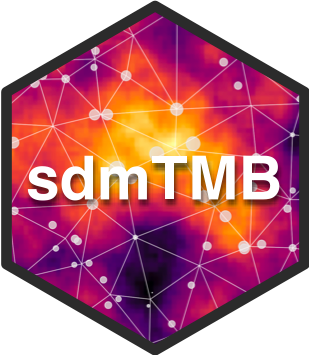Spatial and spatiotemporal GLMMs with TMB
sdmTMB is an R package that implements spatial and spatiotemporal predictive-process GLMMs (Generalized Linear Mixed Effects Models) using Template Model Builder (TMB), R-INLA, and Gaussian Markov random fields. One common application is for species distribution models (SDMs).
Assuming you have a C++ compiler installed, you can install sdmTMB:
# install.packages("remotes")
remotes::install_github("pbs-assess/sdmTMB")sdmTMB:
- Fits GLMMs with spatial, spatiotemporal, spatial and spatiotemporal, or AR1 spatiotemporal Gaussian Markov random fields with TMB. It can also fit spatially varying local trends through time as a random field.
- Uses formula interfaces for fixed effects and any time-varying
effects (dynamic regression)
(e.g.
formula = y ~ 1 + x1 + (1 | g), time_varying = ~ 0 + x2), whereyis the response,1represents an intercept,0omits an intercept,x1is a covariate with a constant effect,(1 | g)is a random intercept across groupsg, andx2is a covariate with a time-varying effect. - Can handle formulas with splines from mgcv. E.g.,
y ~ s(x, k = 4). - Can handle linear breakpoint or logistic threshold fixed effects:
y ~ breakpt(x1)ory ~ logistic(x2). - Uses a
family(link)format similar toglm(), lme4, or glmmTMB. This includes Gaussian, Poisson, negative binomial, gamma, binomial, lognormal, Student-t, and Tweedie distributions with identity, log, inverse, and logit links. E.g.,family = tweedie(link = "log"). - Has
predict()andresiduals()methods. The residuals are randomized-quantile residuals similar to those implemented in the DHARMa package. Thepredict()function can take anewdataargument similar tolm()orglm()etc. The predictions are bilinear interpolated predictive-process predictions (i.e., they make smooth pretty maps). - Has a simulation function
sdmTMB_sim()for simulation testing models andsdmTMB_cv()for cross-validation testing of model accuracy or comparing across model configurations. - Includes functionality for estimating the centre of gravity or total biomass by time step for index standardization.
- Can optionally allow for anisotropy in the random fields (spatial correlation that is directionally dependent) and barriers (e.g., land for ocean species) to spatial correlation.
- Can generate an SPDE predictive-process mesh or can take any standard R-INLA mesh created externally as input.
The main function is sdmTMB(). See ?sdmTMB and ?predict.sdmTMB for
the most complete examples. Also see the vignettes (‘Articles’) on the
documentation site.
